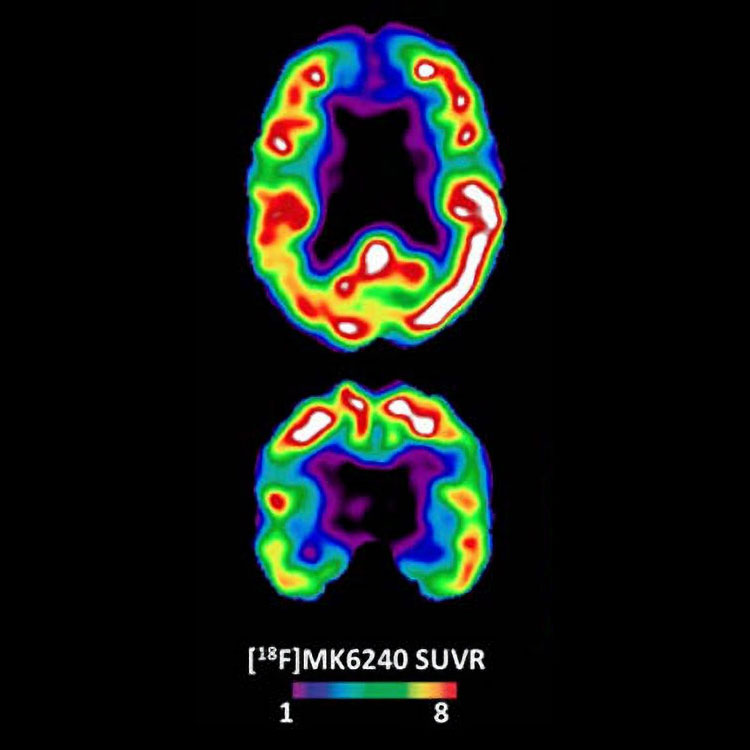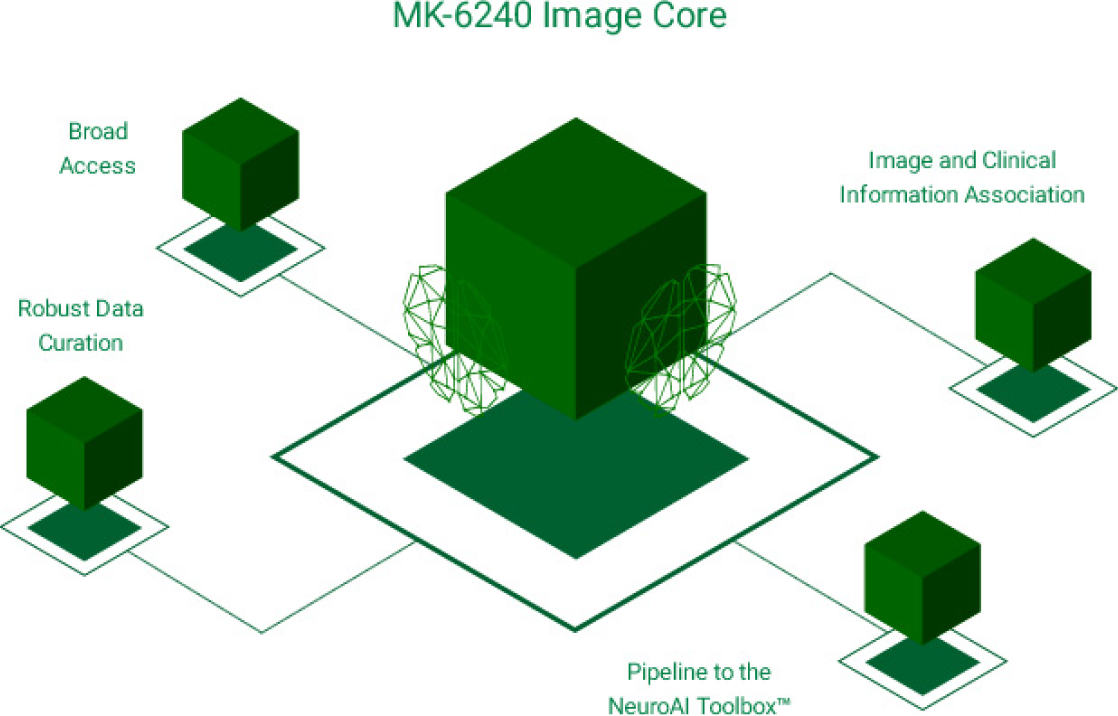Science
18F-MK-6240: A next-generation imaging biomarker
MK-6240 is an investigational next-generation Tau PET tracer with the following properties:
- High binding levels to brain regions with a plausible pattern for neurofibrillary tangles (NFT) deposition in AD subjects1
- Low off-target binding supporting the detection and quantification of early tau deposition2
- Favorable kinetics with rapid brain delivery and washout3
- Favorable safety profile and wide dynamic range with low within-brain background4
- Excellent reproducibility between test and retest scans5
These characteristics are critical to demonstrate ease of use, reproducibility and clinical relevance supporting the clinical utility of MK-6240.6
MK-6240 is situated to provide high-yield doses and allow long-distance shipment with global reach. It is used in numerous research collaborations with industry and academia worldwide.

MK-6240 PET images from an amyloid and tau-positive subject with biologically defined AD.
Courtesy of Pedro Rosa-Neto, MD, PhD; McGill University
Hallmark biomarkers7
Misfolded beta-amyloid and tau proteins form plaques and neurofibrillary tangles (NFTs), which interfere with synaptic communication between nerve cells and are pathologic hallmarks of AD. Amyloid deposition begins well before cognitive signs start to manifest. However, the presence of tau deposits is increasingly associated with cognitive decline.
Neuroimaging
Aβ neuritic plaques and tau aggregates represent a critical pathology in AD and other non-AD tauopathies. Tau in AD is both temporally and spatially distributed based on the severity of disease and seems to be more closely correlated to cognitive decline than Aβ neuritic plaques. Next generation tau ligands like MK-6240 have optimal kinetics and less off-target binding allowing optimal quantification.7
Bourgeat et al. (2023) compared tau tracers, both cross-sectionally and longitudinally by case-matching subjects in the Australian Imaging Biomarkers and Lifestyle study (AIBL) and Alzheimer’s Disease Neuroimaging Initiative (ADNI) longitudinal cohort studies. A subset of 113 participants from AIBL and 113 from ADNI imaged using 18F-MK-6240 and 18F-FTP respectively, with baseline and follow up, were matched based on baseline clinical diagnosis, MMSE, age, and amyloid (A) PET centiloid value. Subjects were grouped as 64 Aβ- cognitively unimpaired (CU), 22 Aβ+ CU, 14 Aβ+ mild cognitive impairment (MCI) and 13 Aβ+ Alzheimer’s disease (AD). Tracer retention was measured in the mesial, temporoparietal, rest of the cortex, and a meta-temporal region composed of entorhinal, inferior/middle temporal, fusiform, parahippocampus and amygdala. T-tests were employed to assess group separation at baseline using SUVR Z-scores and longitudinally using SUVR%/Yr. Only 18F-MK-6240 showed statistically significant higher rate of SUVR increase in Aβ+ CU compared to Aβ- CU in the mesial, meta-temporal and temporoparietal regions. Researchers concluded 18F-MK-6240 appears to be a more sensitive tracer for change in tau level at the preclinical stage of AD.8
MMSE = Mini-Mental State Examination; PET = positron emission tomography; SUVR = standardized uptake value ratio
Managing image data
MK-6240 images from our Users Group and others are warehoused in the Lantheus Cerveau Image Core. Associated imaging, blood chemistry and cognitive assessments are often also archived. Great care is exercised in quality control of these data, and curation is constant. All parties contributing to the Image Core—the Lantheus Cerveau Users Group—have access to the precompetitive data sets.

This product candidate is an investigational drug that has not yet been approved as safe and effective.
References:
- Krishnadas N, Doré V, Robertson JS, Ward L, Fowler C, Masters CL, Bourgeat P, Fripp J, Villemagne VL, Rowe CC. Rates of regional tau accumulation in ageing and across the Alzheimer’s disease continuum: an AIBL 18F-MK-6240 PET study. EBioMedicine. 2023 Feb;88:104450. doi: 10.1016/j.ebiom.2023.104450. Epub 2023 Jan 27. PMID: 36709581; PMCID: PMC9900352.
- Lohith TG, Bennacef I, Vandenberghe R, Vandenbulcke M, Salinas CA, Declercq R, Reynders T, Telan-Choing NF, Riffel K, Celen S, Serdons K, Bormans G, Tsai K, Walji A, Hostetler ED, Evelhoch JL, Van Laere K, Forman M, Stoch A, Sur C, Struyk A. Brain imaging of Alzheimer dementia patients and elderly controls with 18F-MK-6240, a PET tracer targeting neurofibrillary tangles. J Nucl Med. 2019 Jan;60(1):107-114. doi: 10.2967/jnumed.118.208215. Epub 2018 Jun 7. PMID: 29880509.
- Pascoal TA, Shin M, Kang MS, Chamoun M, Chartrand D, Mathotaarachchi S, Bennacef I, Therriault J, Ng KP, Hopewell R, Bouhachi R, Hsiao HH, Benedet AL, Soucy JP, Massarweh G, Gauthier S, Rosa-Neto P. In vivo quantification of neurofibrillary tangles with [18F]MK-6240. Alzheimers Res Ther. 2018 Jul 31;10(1):74. doi: 10.1186/s13195-018-0402-y. PMID: 30064520; PMCID: PMC6069775.
- Koole M, Lohith TG, Valentine JL, Bennacef I, Declercq R, Reynders T, Riffel K, Celen S, Serdons K, Bormans G, Ferry-Martin S, Laroque P, Walji A, Hostetler ED, Briscoe RJ, de Hoon J, Sur C, Van Laere K, Struyk A. Preclinical safety evaluation and human dosimetry of [18F]MK-6240, a novel PET tracer for imaging neurofibrillary tangles. Mol Imaging Biol. 2020 Feb;22(1):173-180. doi: 10.1007/s11307-019-01367-w. PMID: 31111397.
- Salinas C, Lohith TG, Purohit A, Struyk A, Sur C, Bennacef I, Beaver J, Martarello L. Test-retest characteristic of [18F]MK-6240 quantitative outcomes in cognitively normal adults and subjects with Alzheimer’s disease. J Cereb Blood Flow Metab. 2020 Nov;40(11):2179-2187. doi: 10.1177/0271678X19887781. Epub 2019 Nov 11. PMID: 31711342; PMCID: PMC7585918.
- Shuping JL, Matthews DC, Adamczuk K, Scott D, Rowe CC, Kreisl WC, Johnson SC, Lukic AS, Johnson KA, Rosa-Neto P, Andrews RD, Van Laere K, Cordes L, Ward L, Wilde CL, Barakos J, Purcell DD, Devanand DP, Stern Y, Luchsinger JA, Sur C, Price JC, Brickman AM, Klunk WE, Boxer AL, Mathotaarachchi SS, Lao PJ, Evelhoch JL. Development, initial validation, and application of a visual read method for [18F]MK-6240 tau PET. Alzheimers Dement (N Y). 2023 Feb 12;9(1):e12372. doi: 10.1002/trc2.12372. PMID: 36873926; PMCID: PMC9983143.
- Aksman LM, Oxtoby NP, Scelsi MA, Wijeratne PA, Young AL, Alves IL, Collij LE, Vogel JW, Barkhof F, Alexander DC, Altmann A; ADNI. A data-driven study of Alzheimer’s disease related amyloid and tau pathology progression. Brain. 2023 Dec 1;146(12):4935-4948. doi: 10.1093/brain/awad232. PMID: 37433038; PMCID: PMC10690020.
- Bourgeat P, Krishnadas N, Doré V, Mulligan R, Tyrrell R, Bozinovski S, Huang K, Fripp J, Villemagne VL, Rowe CC. Cross-sectional and longitudinal comparison of tau imaging with 18F-MK-6240 and 18F-Flortaucipir in populations matched for age, MMSE and brain beta-amyloid burden. J Prev Alzheimers Dis. 2023;10(2):251-258. doi: 10.14283/jpad.2023.17. PMID: 36946452.